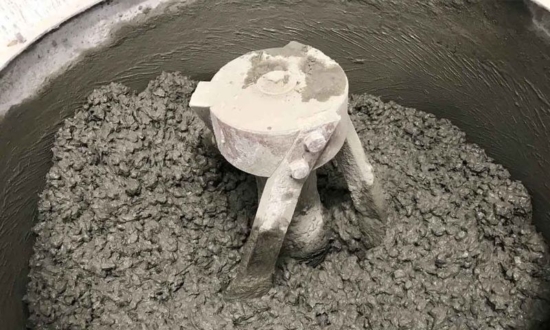Greener & lighter: Uni team develops ‘tyre concrete’
 Concrete mixing using recycled tyre rubber particles for the complete replacement of traditional coarse aggregates. (Photo: Mohammad Islam, RMIT)
Concrete mixing using recycled tyre rubber particles for the complete replacement of traditional coarse aggregates. (Photo: Mohammad Islam, RMIT)
Engineers from Australia’s RMIT University have managed to replace 100 per cent of conventional aggregates in concrete – such as gravel and crushed rock – with rubber from discarded tyres to create a product that meets building codes. The team behind the project says that in addition to contributing to the circular economy, the new greener and lighter concrete also promises to reduce manufacturing and transportation costs significantly.
Small amounts of rubber particles from tyres are already used to replace concrete aggregates, but previous efforts to entirely replace aggregates with rubber have produced weak concretes that failed to meet the required standards. The RMIT University study, published in the Resources, Conservation & Recycling journal, reveals a manufacturing process for structural lightweight concrete where the traditional coarse aggregates in the mix were completely replaced by rubber from used car tyres.
Mohammad Momeen Ul Islam, lead author and PhD researcher from RMIT University’s School of Engineering, says the findings “debunked a popular theory” on what could be achieved with recycled rubber particles in concrete.
“We have demonstrated with our precise casting method that this decades-old perceived limitation on using large amounts of coarse rubber particles in concrete can now be overcome,” elaborates Islam. “The technique involves using newly designed casting moulds to compress the coarse rubber aggregate in fresh concrete that enhances the building material’s performance.”
This advance builds upon the January 2021-announced invention of this technique by fellow RMIT University Engineers Professor Yufei Wu, Dr Syed Kazmi, Dr Muhammad Munir and Shenzhen University’s Professor Yingwu Zhou. Several phase patent applications for this have been filed in Australia.
Greener, cheaper & lighter building materials
Study co-author and team leader, Professor Jie Li, said this manufacturing process will unlock environmental and economic benefits. “As a major portion of typical concrete is coarse aggregate, replacing all of this with used tyre rubber can significantly reduce the consumption of natural resources and also address the major environmental challenge of what to do with used tyres,” he adds.
About 1.2 billion waste tyres will be disposed of annually worldwide by 2030. Australia’s government outlawed the export of end-of-life tyres in December 2021, making new methods for recycling and reprocessing them locally increasingly important.
Furthermore, Li anticipates that a greener and lighter tyre-based concrete could greatly reduce manufacturing and transportation costs. “This would benefit a range of developments including low-cost housing projects in rural and remote parts of Australia and other countries around the world.”
Cost-effective upscaling
According to Islam, the team’s manufacturing process could be scaled up cost-effectively within a precast concrete industrial setting in Australia and internationally. Following successful testing in the workshop, the team is now looking into reinforcing the concrete to see how it can work in structural elements.
The RMIT research team also includes Professor Yu-Fei Wu, Dr Rajeev Roychand and Dr Mohammad Saberian.



Comments